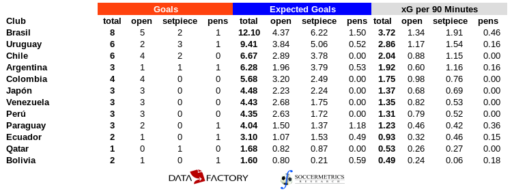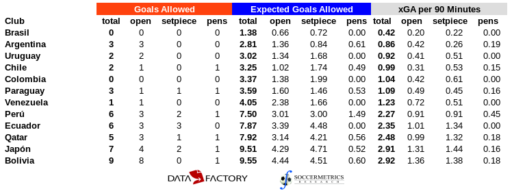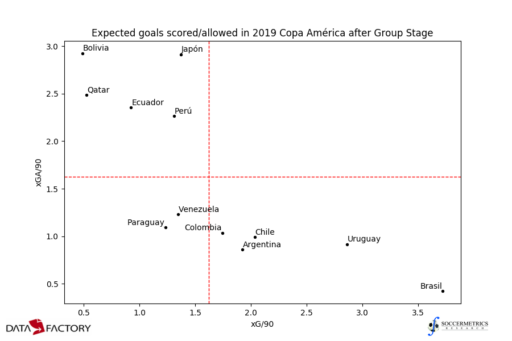More thoughts on the Copa América after the Group Stage
Categories: Competition Analysis
After eighteen matches and 40 goals, the group stage of the 2019 Copa América concluded on Monday. I wrote my initial thoughts on the tournament just before the start of the last matchday. With the competition in a two-day pause before the quarterfinals commence, it’s time to look back on the group stage in its entirety and look ahead to the business end of Copa América.
The final eight teams are the best teams left in the tournament. All but one of the quarterfinalists rank among the top eight in actual goals scored and allowed, as well as expected goals scored and allowed. Here is what the team rankings look like:


People could quibble about Japan in place of Paraguay, and they would have a better than decent argument. Japan scored more goals and created more than Paraguay, but the Albirroja‘s defensive record was significantly superior than the Japanese. In fact, the defensive record of the quarterfinal teams was so much better than those that exited early:

Barcelona players lead the way in the expected charts. Two mega-stars and one on the margins — Luis Suárez, Lionel Messi, and Philippe Coutinho — lead the Copa América in total combined expected goals and assists. Suárez leads in total expected goals (3.74 xG) and expected goals from open play (2.09 xG), Messi in total expected assists (3.43 xA), and Coutinho in expected assists from open play (1.36 xA). Suárez is the only player to have generated more than 3.0 xG, and only three players have created more than 2.0 xA (Messi, Coutinho, and Paolo Guerrero).
But Miguel Almirón has outperformed his expected performance. When you combine actual goals and assists and compare the result to the player’s expected goals and assists, a very different table emerges. Topping the list is Brazil’s Everton, whose three combined goals and assists have eclipsed his 0.81 xA[G]. Second on the list is Miguel Almirón, thanks to his two assists in the tournament. The only other players who overperformed their expected xA[G] by more than 0.95 unit was Koji Miyoshi, of Japan and Yokohama F-Marinos, Darwin Machís of Venezuela, and Tarek Salman of Qatar. At the bottom of such a list? Gabriel Jesus, Luis Suárez, and Lionel Messi.
Number 6 has been the most important position on the field. The eigenvector centrality metric — which identifies the players most important to their team’s passing network — shows that a lot of the distribution goes through those holding midfielders. All of the teams have positioned one or two midfielders in front of the back line, and one of those players invariably becomes the focal point. Examples in this tournament have been Rodrigo Betancur for Uruguay or Charles Aránguiz for Chile. In other teams, the focal point is on a more forward player, such as an offensive playmaker like Almirón or Coutinho. Here’s a list of the three players on each squad with highest eigenvector centrality metrics:
| Team | Highest Network Centrality Values (appearances/value) |
| Argentina | Rodrigo De Paul (3/0.40), Leandro Paredes (3/0.39), Renzo Saravia (2/0.35) |
| Bolivia | Diego Bejarano (3/0.40), Fernando Saucedo (3/0.33), Alejandro Chumacero (2/0.41) |
| Brazil | Philippe Coutinho (3/0.36), Casemiro (3/0.36), Arthur (2/0.63) |
| Chile | Charles Aránguiz (3/0.42), Alexis Sánchez (3/0.38), Arturo Vidal (2/0.39) |
| Colombia | Juan Cuadrado (3/0.35), Wilmar Barrios (3/0.29), Mateus Uribe (2/0.49) |
| Ecuador | Jéfferson Orejuela (3/0.46), Pedro Velasco (3/0.40), Arturo Mina (2/0.34) |
| Japan | Gaku Sibasaki (3/0.42), Shoya Nakajima (3/0.35), Ko Itakura (2/0.36) |
| Paraguay | Miguel Almirón (3/0.38), Santiago Arzamendia (3/0.36), Gustavo Gómez (2/0.41) |
| Peru | Ángel Trauco (3/0.39), Jefferson Farfán (3/0.35), Carlos Zambrano (2/0.29) |
| Qatar | Abdulaziz Mohammed (3/0.47), Hassan Al Haydos (3/0.32), Abdelkarim Fadlalla (2/0.32) |
| Uruguay | Rodrigo Betancur (3/0.44), Martín Cáceres (3/0.32), Giovanni González (2/0.32) |
| Venezuela | Roberto Rosales (3/0.39), Júnior Moreno (3/0.35), Luis Del Pino (2/0.33) |
Brazil and Uruguay are on a collision course. They have emerged from the group stage as the two best and most consistent teams in the competition, the basic statistics and advanced metrics back up that observation, and they reside in separate halves of the knockout bracket. There remain a couple more matches to navigate, but the anticipation will build as the final approaches. And if you don’t think that Uruguay is looking forward to create another Maracanazo, you need a serious rethink.
This post has been prepared with match event data supplied by DataFactory Latinoamérica.

